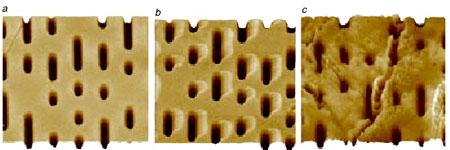Bij CDR-Info is een zeer uitgebreid artikel verschenen over alles wat komt kijken bij het bepalen van de kwaliteit van een CD. Het artikel legt uit waardoor leesfouten kunnen optreden. Verder wordt uitgebreid besproken welke error correctie mechanisme's aanwezig in CD's en CD-spelers, hoe deze werken en welk type errors deze wel en niet kunnen corrigeren. Aan het eind van het artikel wordt aandacht geschonken aan de methode's waarmee de kwaliteit van CD's gecheckt kan worden. Hieronder een paar illustraties gemaakt met een AFM microscoop:
In Figure a, the pit structure is uniform and replicates the stamper accurately.
In Figure b, the pits are locally deformed with polycarbonate piled up or smeared toward the perimeter of the disk. This deformation is manifested as visible staining and can lead to high block error rates depending on degree.
In Figure c, the polymer surface is severely distorted and some of the pits are barely recognizable.
In the lands (surfaces surrounding pits), the polymer appears to have stuck to the stamper during disc ejection leading to severe deformation. Note that the molding conditions used here to demonstrate severe staining are atypical; area [C] in particular represents surface deformations which are rarely seen in actual disc production.

Met dank aan RawPeanut voor de tip.
